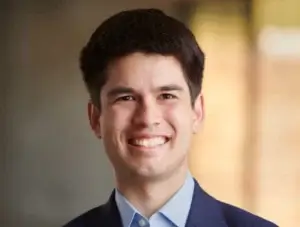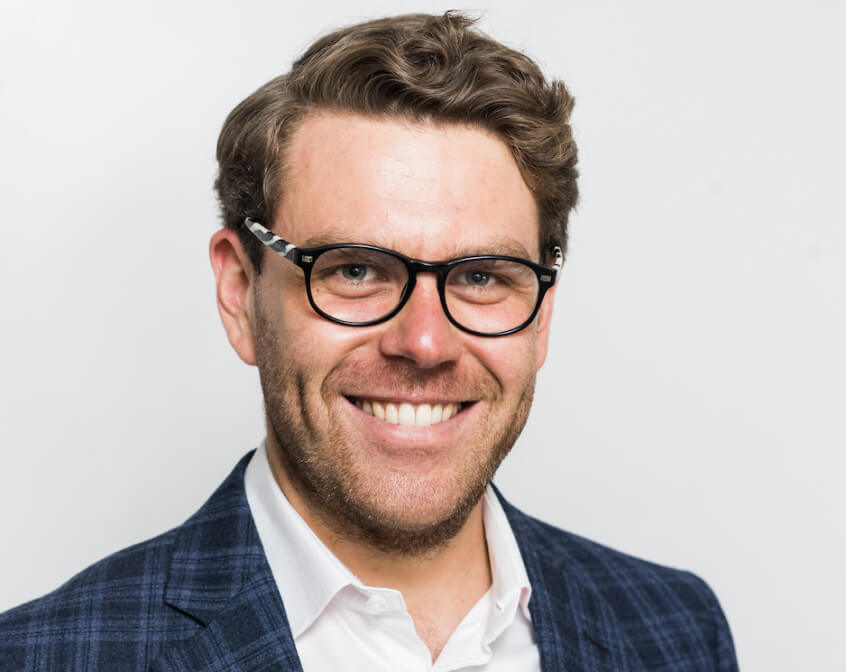As the founder and CEO of Klarity, Andrew Antos understands how powerful of an effect automation can have on increasing the efficiency and speed within a business. Klarity automates the revenue accounting process, a highly manual series of tasks that accounting teams need to perform any time their company signs a contract with a customer.
Today we sit down with Andrew as part of our ongoing founder interview series. We discuss the impact of automation, the startup environment today, and how Klarity improves & accelerates accounting processes.
Interview
Brandon Deer: Andrew thanks for joining us. For our readers who don’t know you, you’re the founder of Klarity, which we at Crew invested in during your Series A round. Before we dive into Klarity and the topic of automation, tell us more about your background and how you founded Klarity.
Andrew Antos: Thanks Brandon. So I was a corporate lawyer in my previous life. I was in an M&A department, which meant I was spending huge amounts of time taking documents and turning them into spreadsheets. I realized that there’s a big portion of white collar workers who are wasting all this human potential on document review. I came to the US 6 years ago, met my co-founder Nischal, who was finishing MIT with a focus on NLP and CS. Together we decided to build a tool that can automatically read documents, complete checklists and free up humanity from this highly repetitive task.
Brandon Deer: That’s an ambitious vision, and one that definitely resonates. Let’s go deeper into Klarity – what the software does, who are your customers, and what is the value Klarity provides to them?
Andrew Antos: Klarity is a SaaS product that automates the processes required to comply with accounting regulations, specifically ASC 606 / IFRS 15 and SOX 404. Klarity completes a revenue checklist by pulling data from documents and from other systems. Typically, most of the data comes from signed contracts, order forms, SOWs, POs, invoices, and different systems of record like Salesforce and NetSuite.
For example, a key differentiator is that accountants can set parameters of what they consider to be “non-standard” language in a contract, which would require human attention as part of reviewing the deal and completing a checklist. Klarity will fill in the checklist for every single deal, and only flag the ones that actually require human judgment, based on the parameters you set. Typically we’re able to fully automate about 87% of this work, and only the rest of 13% actually require human judgment.
Brandon Deer: Bringing a classic value proposition of software – automation – to accounting teams. That’s great. How big of a deal to accounting teams is this particular workflow around revenue recognition?
Andrew Antos: Well, imagine a situation where, say you’re a SaaS company, and you sign maybe 100 new deals on average every month. For each deal, your accounting team has to manually review, read, and process all the documents related to the deal. Then they have to compare the data in the documents with the data in their core systems like Netsuite to ensure everything is accurate from an accounting perspective. Klarity does that automatically, which helps close books faster (2 days on average!) and increases accuracy by 37%.
I was talking to one of our customers last week, a public company, who has a team of 5 full time employees who do these contract reviews. Before implementing Klarity, it took them 3 days at the end of every month to do the whole process, now they do it in 2-3 hours.
Brandon Deer: Oftentimes software doesn’t have a clear or tangible return on investment. Or it can be hard to measure. Klarity is different though, because it’s so straightforward – you save accounting teams time on manual contract review workflows. I think there’s maybe a lesson here for other early stage software founders who also have companies that offer this type of tangible ROI to their customers. When you’re working with your customers’ accounting teams, how do you communicate that ROI to them? What types of KPIs or metrics do you track to prove to them that Klarity is worth their investment?
Andrew Antos: I do not think there is an end state to communicating your product’s value proposition. We’re still learning and constantly shaping it. So far we focus on 3 main tangible ROI attributes and we measure them with a lot of attention: time and cost saved, faster closed books, and accuracy. These are the things that matter to our audience – Chief Accounting Officers, Controllers and Accountants, Directors of Revenue – this is why they buy Klarity in the first place.
The purpose of every accountant is to ensure accuracy and compliance with regulations and accounting principles. Klarity is a tool that helps them achieve the core purpose of their job. This means we’re aligned with our customer’s purpose in the world. The second thing is that as a non-revenue generating function in a company, accountants are always asked to do more with less. Meanwhile there’s more and more regulation, which basically decreases efficiency.
Ultimately, we’re trying to help accounting teams get through all these compliance requirements more efficiently, so that they can work on other areas that deliver tangible value to their company.
Finally, if you are able to close the books faster, that means the business can have an accurate picture of what happened last month or last quarter earlier. Many important business decisions can thus take place faster.
Brandon Deer: So it’s about aligning the core “job to be done” from your user/customer with the core value prop of your product. Considering the hours of manual review that Klarity frees up for accounting teams, what have you seen be your biggest customers’ operational response to that? Do they move accountants around to different teams? Do employees focus on other tasks? When the public hears about technology and automation, it seems like often the first concern is will this replace people’s jobs? Are you seeing that happen among your customers, as a result of them adopting Klarity?
Andrew Antos: Well, it depends on the company, but basically there are three different things that we see our customers doing with the extra time that Klarity saves their accounting teams.
First, some customers used to have their accounting teams spending weekends and pulling 18 hour long work days to close the books on time. So that doesn’t happen anymore with Klarity. Obviously that improves work life balance for the accountants and can help with employee retention.
Second, our customers don’t need to hire as large accounting teams to do this type of compliance related work, which honestly can be boring and repetitive. There isn’t a lot to be learned from doing these processes manually. If you can avoid them, you also avoid a lot of cost and complexity.
And last thing to mention is that these teams are freed up to do more creative work. Accounting teams always have to do more with less, and they’re usually understaffed. Accounting isn’t as much of a center for budgets as say GTM or engineering. But Klarity allows them to have more time to catch up on other more creative parts of the job like pricing analysis or SSP analysis.
Brandon Deer: One of the things that we’re interested in getting your thoughts on is the regulatory environment. Many of the reasons why the revenue recognition process is so complicated in the first place are related to regulations. So first off, what are the big 2 or 3 regulations that your customers use Klarity to help them comply with?
Andrew Antos: So the first thing to note is that revenue gives you the sense of how a company is performing, and for public or private investors it is a key factor into their investment decisions. Accounting statements, a P&L, free cash flow and earnings – all of this stuff comes downstream of making sure that revenue is accounted for accurately.
Let’s go back to the example I mentioned with the SaaS company that’s closing 100 deals every month. Depending on how you actually account for that revenue, it might show two vastly different numbers. There are famous cases like Enron or Computer Associates (CA), where companies misrepresented their revenue. Many of these processes and assurances were put in place as a result of those cases.
The accounting standard that regulates revenue recognition is called ASC 606, which replaced the previous ASC 605. Business models change over time, so these accounting standards change over time too. It’s basically a 5 step framework on how to determine your revenue, based on your contract review. This is something that every company has to do to make sure that all the revenue is accounted for.
In addition to this, there’s also the Sarbanes-Oxley Act that was a response to the Enron scandal in the early 2000s. It doesn’t talk about revenue specifically, but it regulates certain controls that companies have to put in place to make sure that they’re accurately representing their financial health to investors.
Brandon Deer: Super helpful overview. Given your intimate familiarity with what it takes to comply with these laws and regulations. At a high level, what’s your perspective on them? Do they create unneeded inefficiencies, or are they helpful protections? Is there anything you would change about them?
Andrew Antos: Yeah that’s a really interesting question. So, controls are kind of orthogonal to efficiency, right? Because you essentially have to prioritize speed and efficiency, against accuracy and truth. So you have to pick one to optimize for. When a company tells their accounting teams that there needs to be multiple people reviewing contracts to ensure accuracy of revenue recognition, in order to ensure compliance with regulation, well that makes it hard to be efficient.
Regulations like Sarbanes-Oxley basically say: look if you want to have access to the public markets and this huge base of investors and the liquidity that comes along with that, then you have to be willing to put in the time to ensure truthful representation of your company’s state. That comes at the price of lower efficiency.
So what we at Klarity do is automate those controls, so you can have the best of both worlds. More accurate, and much much faster. This wasn’t possible before because technology didn’t exist that could read documents the way humans can, understanding the different nuances the way that humans can. We have tens of public companies that are relying on Klarity for their SOX 404 controls, and all of them are reporting higher efficiency, higher accuracy, and doing so while ensuring compliance.
Brandon Deer: That’s a great framework in terms of just simplifying why public companies have some of these regulations, ultimately it comes down to ensuring a certain degree of confidence in the state of the business. Are these regulations, and Klarity’s applicability as a result, sector-specific? Or do they apply across the public markets?
Andrew Antos: It’s every vertical. ASC-606 applies to everyone. It’s a five step process to determine how you should determine what counts as “revenue”, and it matters in every industry.
Klarity can help most with companies that deal with licensing, and with variable degrees of volume and discounts. For example, obviously we see that in software of course. But there is a lot of technical licensing in how a company that builds gear boxes for cars, how they license that tech.
Same with Oil & Gas / Energy, where there are multi-year agreements with different pricing and volume levers. There’s complexity with how the gas is transported – is it pipeline or via ship? When is it delivered? These things impact revenue recognition, and Klarity helps companies streamline that process.
Retail is another example. Remember Under Armor was under investigation? There were certain issues related to how they were recognizing revenue related to clothing that was being delivered to distributors. There’s a lot of this revenue complexity in retail – are you selling to a distributor or a retailer? Are you offering rebates? Volume discounts?
If your business is 100% consumer-focused, B2C, then revenue recognition is simpler.
Brandon Deer: Before we lose our audience in the intricacies of accounting regulations, let’s go back to talking about the startup environment today, and how you run the business at Klarity. Klarity is a consumer of software and technology itself. How have you guys thought about balancing adopting new internal tools to continue to increase speed and efficiency, with the increased need to manage burn in the current environment?
Andrew Antos: We believe it’s a cultural trait that we want to instill in our company, that balance. My leadership team’s focus is on how we can solve a specific problem. What’s our buying and efficiency measuring behavior like? Are the tools we’re buying really help us or not?
You can measure “efficiency” in so many different ways. For example, how many engineers do we have vs. the number of customers? How many sales people do we have against revenue? How much money are we spending on internal software tooling vs. our total revenue, or the number of people in the organization?
We manage a variety of these types of metrics, and many others, and review them on Mondays in our weekly executive team meeting. They give us a sense for how efficient every department is, and that becomes part of the culture and how we run our business. For us it all comes down from this obsession about efficiency and measuring things constantly.
Brandon Deer: What would be your advice to other founders trying to manage that balance in the current business environment? Or in other words, the challenge of trying to do more – build product, grow, move faster – while being expected to do it with less capital and fewer people?
Andrew Antos: Two things come to my mind – customer and product. These are the things we focus on. We are obsessed with understanding our customers’ problems and with building a product which solves those problems.
People often get distracted by competition. They get distracted by industry reports. They look at these and think they should place their company in some type of bucket or category. They think they need to achieve feature parity with other players in their space and be similar but better than them. Personally, I think that’s not the best way to think about markets. We focus on our customers, on defining our customers with a high degree of precision. We build to what the market, our customers – actually want. We know what others are building, but ultimately we don’t care about what features they have – we only care about our customers and helping bring them more value from our product over time.
Brandon Deer: Thanks so much for sitting down with us today Andrew. For readers interested in learning more about Klarity, check out their website.
Related Articles

From Early Vision to Software Giant: Lavinia Cojocaru’s Journey to Building a Generational Technology Business
Lavinia Cojocaru knows what it's like to build a successful startup from the ground up: As co-founder and lead software…

Guy Podjarny’s Journey to Building Snyk
“Satisfaction comes out of struggle” was one of many thought-provoking ideas expressed by Guy Podjarny at the Crew Capital &…

Spenser Skates’ Journey from MIT to Building the Category-Defining Digital Analytics Company
As part of our founder interview series, Crew Capital’s Co-founder, Daniel Dines, sat down with Skates to have a conversation…








